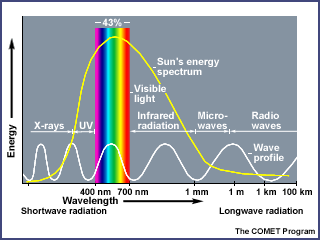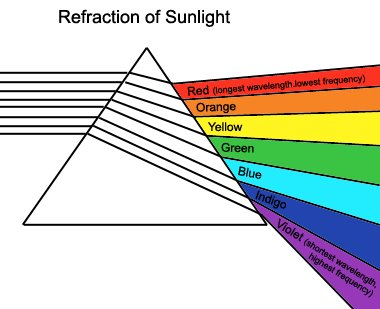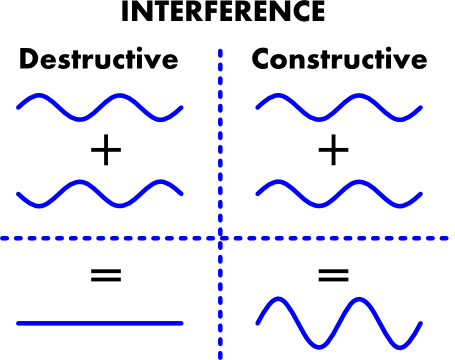
Primary rainbow with supernumerary bows and a faint secondary bow. Photo from Noboru Chikira, 21 Apr 2016, Oahu, Hawaii.
No, your vision isn’t blurred. There are actually additional colored bands bordering the bright primary rainbow in this picture from the Hawaiian Island of Oahu. These faint, pastel bands of light are referred to as supernumerary bows. “Supernumerary” means “more numerous” and is an adjective used not only for describing this optical phenomenon, but also for everything from teeth to military officers. To understand how these bands form, we first need to consider what creates a rainbow in the first place.
Rain showers over the tropical Hawaiian Islands, and elsewhere, can lead to vibrant rainbows. How does this occur? First, consider the energy emitted by the sun, which includes waves of energy in the UV, infrared, and visible portions of the electromagnetic spectrum. Most of the sun’s energy is emitted as visible light, which includes a range of colors (ROYGBIV).

In 1665 Isaac Newton, through his infamous prism experiment, was able to prove that the white light of the sun was actually composed of a color spectrum. The sun’s visible light entered the prism and was refracted (bent) through the prism, with the red (longest wavelength) bending the least and the shorter wavelength violet bending the most.

A raindrop falling from a cloud can act as a prism, bending and reflecting the light to produce the colors of the rainbow. When the sunlight encounters a raindrop, some of the light is bent as it enters the drop. This refracted light hits the back of the raindrop, is reflected internally within the drop, then is bent (refracted) once again as it exits the drop.

Because the different colors of the sunlight bends at different angles, the result of one internal reflection means the primary rainbow will have red on the outside and blue on the inside. This process happens to an assortment of raindrops falling from the sky leading to the existence of many rainbows at the same time; however, which one you see (and how much of one you see) depends on your viewpoint relative to the angle of the sun above the horizon behind you.
Sometimes, a second, fainter rainbow can be seen in the sky. This secondary rainbow results from two internal reflections (instead of one) inside the raindrop, leading to the colors appearing in the opposite order as the primary bow. In the following picture, you can see the faint secondary bow in the upper right.

Primary rainbow with supernumerary bows and a faint secondary bow. Photo from Noboru Chikira, 21 Apr 2016, Oahu, Hawaii.
The key to the formation of rainbows, is therefore dependent on the sunlight, raindrops, and how much and how many times the sunlight bends and reflects within the drop. To understand supernumerary bows, the feature of this post, it’s important to remember that rays of light are waves of energy. Think of the ripples and waves that form on a water surface and what happens when they interact with each other. Some can counteract and destroy each other, while others can join to make a bigger wave. A similar description can be applied to waves of light.
The distance between the crests of these waves of energy is referred to as the wavelength (recall red light has a longer wavelength than blue).

If the waves are in sync with each other, they can constructively interfere to amplify the wave. If they are out of sync (out of phase) with each other, they can destructively interfere to cancel each other out.

So with this in mind, given the different angles of refraction for the different colors of the sun’s rays when sunlight encounters and is bent through and around a raindrop, there is bright light where the crests of waves are aligned (and therefore constructively interfere); similarly, there is darkness where the waves of light destructively interfere. Each of the bright fringes is a supernumerary bow, created by interference between different portions (colors) of the same light wave.
Why can’t we always see supernumerary bows? Well, their presence depends on the size of the raindrops. Supernumerary bows can only be seen when the sunlight encounters small raindrops that are all nearly the same size. In a typical rain storm, there are drops falling of many different shapes and sizes, which would wash out the colors of the supernumerary bows. Basically each differently sized raindrop would produce differently spaced, overlapping fringes that would blur. There is a sweet spot, though, because as the drops become even smaller, the bow broadens, the colors become less saturated, and eventually there is no longer a vibrant rainbow but a faint cloudbow or fogbow. An excellent description of these bows and their dependence on drop size can be found here: http://www.atoptics.co.uk/rainbows/supdrsz.htm
The first explanation for supernumerary bows was provided by the English physician and scientist Thomas Young in 1804.